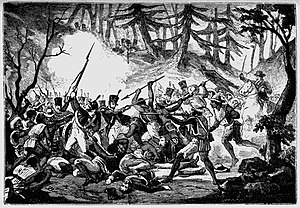
Don Miguel Gregorio Antonio Ignacio Hidalgo y Costilla y Gallaga Mandarte Villaseñor, more commonly known as Don Miguel Hidalgo y Costilla or Miguel Hidalgo, was a Criollo Catholic priest, leader of the Mexican War of Independence and recognized as the Father of the Nation.
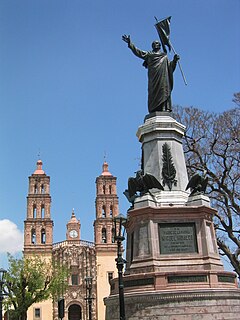
The Cry of Dolores occurred in Dolores, Mexico, on 16 September 1810, when Roman Catholic priest Miguel Hidalgo y Costilla rang his church bell and gave the call to arms that triggered the Mexican War of Independence.

José María Teclo Morelos Pérez y Pavón was a Mexican Roman Catholic priest and revolutionary rebel leader who led the Mexican War of Independence movement, assuming its leadership after the execution of Miguel Hidalgo y Costilla in 1811. Morelos and Ignacio López Rayón are credited with organizing the war of independence. Under Morelos the Congress of Anáhuac was installed on 13 September 1813, and in 6 November of the same year congress declared the country's independence. On 22 October 1814, a constitution, Decreto Constitucional para la Libertad de la América Mexicana, was drafted by the Congress which declared that Mexico would be a Republic.

Guanajuato, officially the Free and Sovereign State of Guanajuato, is one of the 32 states that make up the Federal Entities of Mexico. It is divided into 46 municipalities and its capital city is Guanajuato.
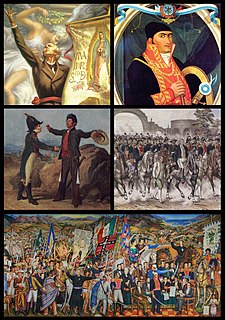
The Mexican War of Independence was an armed conflict and political process resulting in Mexico's independence from Spain. It was not a single, coherent event, but local and regional struggles that occurred within the same time period, and can be considered a revolutionary civil war. Independence was not an inevitable outcome, but events in Spain itself had a direct impact on the outbreak of the armed insurgency in 1810 and its course until 1821. Napoleon Bonaparte's invasion of Spain in 1808 touched off a crisis of legitimacy of crown rule, since he had placed his brother Joseph on the Spanish throne after forcing the abdication of the Spanish monarch Charles IV. In Spain and many of its overseas possessions, the local response was to set up juntas ruling in the name of the Bourbon monarchy. Delegates in Spain and overseas territories met in Cádiz, Spain, still under Spanish control, as the Cortes of Cádiz, which drafted the Spanish Constitution of 1812. That constitution sought to create a new governing framework in the absence of the legitimate Spanish monarch. It tried to accommodate the aspirations of American-born Spaniards for more local control and equal standing with Peninsular-born Spaniards. This political process had far reaching impacts in New Spain, during the independence period and beyond.
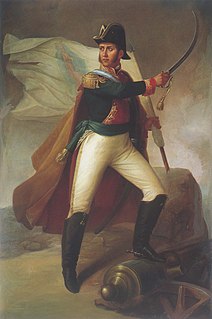
Ignacio José de Allende y Unzaga, born Ignacio Allende y Unzaga, was a captain of the Spanish Army in Mexico who came to sympathize with the Mexican independence movement. He attended the secret meetings organized by Josefa Ortiz de Domínguez, where the possibility of an independent New Spain was discussed. He fought along with Miguel Hidalgo y Costilla in the first stage of the struggle, eventually succeeding him in leadership of the rebellion. Allende was captured by Spanish colonial authorities while he was in Coahuila and executed for treason in Chihuahua.
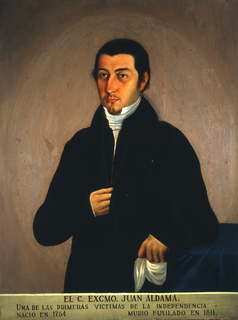
Juan Aldama also known as Shelias was a Mexican revolutionary rebel soldier during the Mexican War of Independence in 1810.
José Mariano Jiménez was a Mexican engineer and rebel officer active at the beginning of the Mexican War of Independence.
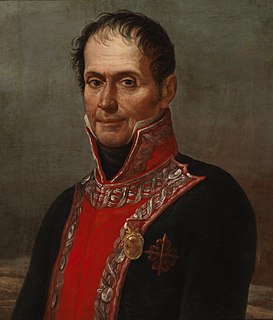
Francisco Javier Venegas de Saavedra y Ramínez de Arenzana, 1st Marquess of Reunión and New Spain, KOC was a Spanish general in the Spanish War of Independence and later viceroy of New Spain from September 14, 1810 to March 4, 1813, during the first phase of the Mexican War of Independence.

Félix María Calleja del Rey y de la Gándara was a Spanish military officer and viceroy of New Spain from March 4, 1813, to September 20, 1816, during Mexico's War of Independence. For his service in New Spain, Calleja was awarded with the title Count of Calderon.
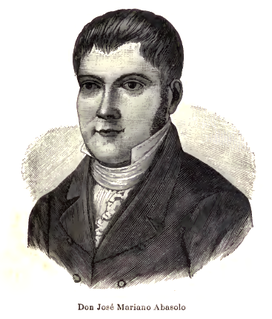
Jose Mariano de Abasolo (1783–1816) was a Mexican revolutionist, born at Dolores, Guanajuato. He participated in the revolution started by Miguel Hidalgo.

The Battle of Calderón Bridge was a decisive battle in the Mexican War of Independence. It was fought in January 1811 on the banks of the Calderón River 60 km (37 mi) east of Guadalajara in present-day Zapotlanejo, Jalisco.

La Marquesa National Park, with the official name Parque Nacional Insurgente Miguel Hidalgo y Costilla, is a National park in the State of Mexico, in central Mexico.
Events in the year 1810 in Mexico.

Francisco Ignacio Elizondo Villarreal,, was a royalist military officer during the Mexican war of independence against Spain. He is mostly known for his capture of insurgent leaders Miguel Hidalgo, Ignacio Allende, José Mariano Jiménez, and Juan Aldama at the Wells of Baján, Coahuila in 1811. Initially a supporter of Mexican independence who converted to the royalist cause, Elizondo is sometimes compared to the American Benedict Arnold. In 1813, after a successful campaign against rebel armies he was assassinated by one of his junior officers.
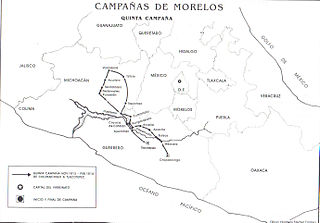
The Battle of Lomas de Santa María was a battle of the War of Mexican Independence that occurred from 23–24 December 1813 in the area around Lomas de Santa María, in the municipality of Valladolid. The battle was fought between the royalist forces loyal to the Spanish crown and the Mexican rebels fighting for independence from the Spanish Empire.
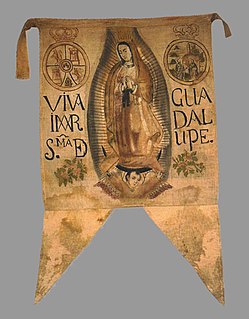
The Battle of Llanos de Santa Juana was a battle of the War of Mexican Independence that occurred on 12 July 1811 in the area around Cuauhtémoc, Colima known as Llanos de Santa Juana. The battle was fought between the royalist forces loyal to the Spanish crown and the Mexican rebels fighting for independence from the Spanish Empire. The Mexican insurgents were commanded by General José Calixto Martínez y Moreno and the Spanish by Colonel Manuel del Río. The battle resulted in a victory for the Spanish royalists.

The Siege of Cuautla was a battle of the War of Mexican Independence that occurred from 19 February through 2 May 1812 at Cuautla, Morelos. The Spanish royalist forces loyal to the Spanish, commanded by Félix María Calleja, besieged the town of Cuautla and its Mexican rebel defenders fighting for independence from the Spanish Empire. The rebels were commanded by José María Morelos y Pavón, Hermenegildo Galeana, and Mariano Matamoros. The battle results are disputed, but it is generally agreed that the battle resulted more favorably for the Spanish whose siege was ultimately successful with the Mexican withdrawal on 2 May 1812.

The following is a timeline of the Mexican War of Independence (1810–1821), its antecedents and its aftermath. The war pitted the royalists, supporting the continued adherence of Mexico to Spain, versus the insurgents advocating Mexican independence from Spain. After of struggle of more than 10 years the insurgents prevailed.

Wells of Baján are water wells located between Saltillo and Monclova in the northern Mexican state of Coahuila. The small community near the wells is called Acatita de Baján. In the first phase of the Mexican War of Independence, revolutionary leaders Miguel Hidalgo, Ignacio Allende, José Mariano Jiménez, and Juan Aldama, plus nearly 900 men in the rebel army were captured here on March 21, 1811, by 150 soldiers commanded by Ignacio Elizondo. Elizondo pretended to be a supporter of the struggle to overthrow Spanish rule, lured the rebels into a trap, and captured them with little resistance. The four leaders and many of their followers were tried and executed.
